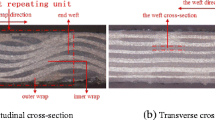Abstract
A composite material are made by combining two or more constituent materials to obtain the desired material properties of each product type. The matrix material which can be polymer and fiber is used as reinforcing material. Currently, the polymer matrix is widely used in many different fields with differently designed structures such as automotive structures and aviation, aerospace, marine, etc. because of their excellent mechanical properties; in addition, they possess the high level of hardness and durability together with a significant reduction in weight compared to traditional materials. However, during design process of structure, there will be many interruptions created for the purpose of assembling the structures together or for many other design purposes. Therefore, when this structure is subject to load-bearing, its failure occurs at these interruptions due to stress concentration. This paper proposes multi-scale modeling and optimization strategies in evaluation of the effectiveness of fiber orientation in an E-glass/Epoxy woven composite 3D shell with circular holes at the center investigated by FEA results. A multi-scale model approach was developed to predict the mechanical behavior of woven composite 3D shell with circular holes at the center with different designs of material and structural parameters. Based on the analysis result of laminae, we have found that the 3D shell with fiber direction of 450 shows the best stress and strain bearing capacity. Thus combining several layers of 450 fiber direction in a multi-layer composite 3D shell reduces the stresses concentrated on the cuts of the structures.

















Similar content being viewed by others
References
Liu, Q., Lin, Y., et al.: Lightweight design of carbon twill weave fabric composite body structure for electric vehicle. Compos. Struct. 97, 231–238 (2013)
Zou, Z.H., Huang, X., et al.: Multi-scale design of composite materials and structures for maximum natural frequencies. Mater Des. 51, 1023–0.34 (2013)
Fu, X., Ricci, S., Bisagni, C.: Minimum-weight design for three dimensional woven composite stiffened panels using neural networks and genetic algorithms. Compos. Struct. 134, 708–715 (2015)
Fu, X., Ricci, S., Bisagni, C.: Multi-scale analysis and optimisation of three-dimensional woven composite structures combining response surface method and genetic algorithms. CEAS Aeronaut. J. 8(1), 129–141 (2016)
Lim, Y.W., Choi, H.-J., Idapalapati, S.: Design of Alporas aluminum alloy foam cored hybrid sandwich plates using kriging optimization. Compos. Struct. 96, 17–28 (2013)
Hesse, S.H., Lukaszewicz, D.H.J.A., Duddeck, F.: A method to reduce design complexity of automotive composite structures with respect to crashworthiness. Compos. Struct. 12, 236–249 (2015)
Li, L.J., Huang, Z.B., Liu, F.: A heuristic particle swarm optimization method for truss structures with discrete variables. Comput. Struct. 87(7–8), 435–443 (2009)
Yathisha, N., Thyagaraj, N.R., et al.: Effect of fibre angle on stress concentration factor in woven E-glass/epoxy composite. ATMECE Mysore. 3, 27–30 (2014)
Xu, X.W., Man, H.C., Yue, T.M.: Strength prediction of composite laminates with multiple elliptical holes. Int. J. Solids Struct. 37, 2887–2900 (2000)
Brian esp.:Stress distribution and strength prediction of composite laminates with multiple holes. University of Texas at Arlington, (2007)
Tan S.C.:Stress Concentrations in Laminated Composites. Technomic Publishing.co.inc, (1994)
Kheradiya, M., Chan, W.S.: Effects of edge distance, hole size ratio and hole spacing on peak stresses of composite laminate with multiple holes. In: University of Texas at Arlington (2008)
Li, S., Wonfsto, A.: Unit cells for micromechanical analyses of particle-reinforced composites. Mech. Mater. 36, 543–572 (2004)
Ghosh, S., Lee, K., Raghavan, P.: A multi-level computational model for multi-scale damage analysis in composite and porous materials. Int. J. Solids Struct. 38, 2335–2385 (2001)
Kanit, T., et al.: Determination of the size of the representative volume element for random composites: statistical and numerical approach. Int. J. Solids Struct. 40, 3647–3679 (2003)
Zhang, C., et al.: Progressive damage simulation of triaxially braided composite using a 3D meso-scale finite element model. Compos. Struct. 125, 104–116 (2015)
Barbero, E.J., Damiani, T.M., Trovillion, J.: Micromechanics of fabric reinforced composites with periodic microstructure. Int. J. Solids Struct. 42, 2489–2504 (2005)
Sherburn M. Geometric and mechanical modelling of textiles. Ph.D. thesis, The University of Nottingham (2007)
Doitrand, A., et al.: Comparison between voxel and consistent meso-scale models of woven composites. Compos. A: Appl. Sci. Manuf. 73, 143–154 (2015)
Dhiman, S., Potluri, P., Silva, C.: Influence of binder configuration on 3D woven composites. Compos. Struct. 134, 862–868 (2015)
Dixit, A., Mali, H.S., Misra, R.K.: Unit cell model of woven fabric textile composite for multiscale analysis. Procedia Eng. 68, 352–358 (2013)
Yathisha, N., et al.: A study on stress concentration factor in woven E-glass/epoxy composite having an elliptical cut out. Int Res J Eng Technol (IRJET). 02, 1539–1544 (2015)
Acknowledgements
This work has been supported by Project of the Key Program of National Natural Science Foundation of China under the Grant Numbers 11572120, National Key R&D Program of China 2017YFB0203701.
Author information
Authors and Affiliations
Corresponding author
Rights and permissions
About this article
Cite this article
Nguyen, D.H., Wang, H. Multi-Scale Analyses of Three Dimensional Woven Composite 3D Shell With a Cut Out Circle. Appl Compos Mater 26, 339–356 (2019). https://doi.org/10.1007/s10443-018-9695-z
Received:
Accepted:
Published:
Issue Date:
DOI: https://doi.org/10.1007/s10443-018-9695-z




